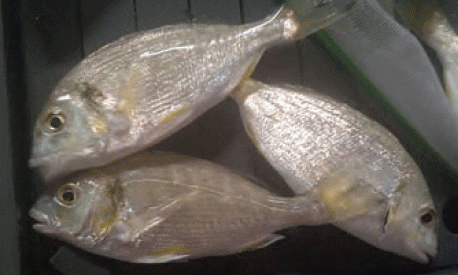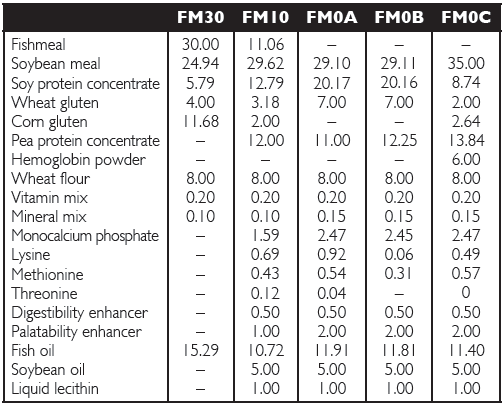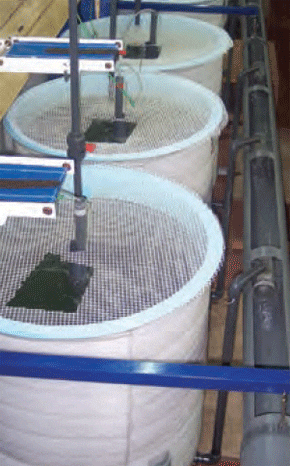
In recent years, fishmeal inclusion levels in commercial aquaculture
feeds have decreased substantially. High market prices,
unpredictable production and increasing ecological concern have
been the basis for this decrease.
Previous work by the authors with gilthead sea bream, Sparus
aurata, found no statistical performance difference between fish
fed diets with 10% or 43% fishmeal in terms of specific growth
rate, feed conversion and somatic indexes. The fishmeal replacement
was based on the use of soybean meal, soy protein concentrate
(SPC), soybean oil and soy lecithin, and appropriate nutritional
compensation in the formula.
In a more recent study, complete fishmeal replacement was
applied. Three diets with no fishmeal were compared to diets
with 30 or 10% fishmeal. Fish oil was also partially replaced by
40% vegetable oil in the feeds with 10% or no fishmeal.
Test Diets
Five diets with 45% crude protein and 20% crude fat were
evaluated: FM30, FM10, FM0A, FM0B and FM0C. The formulations
of the diets are presented in Table 1.
Diet FM30 was a practical formulation representing average
fishmeal levels in high-quality feeds for marine fish, with a significant
replacement of fishmeal with soybean protein. For this
diet, 41% of dietary protein was provided by fishmeal, and 26%
was provided by defatted soybean meal.
In the FM10 diet, only 15% of the protein was provided by
fishmeal, and 59% of the dietary fat was provided by fishmeal
and fish oil. The FM10 formulation was compensated to
improve the essential amino acid balance using pea protein and
amino acid supplementation with lysine, methionine and threonine
to approach the amino acid profile of whole bream.
Supplemental phosphorus was added to increase the available
phosphorus level to 0.65%. Lipid digestibility was stimulated by
adding lecithin and a digestive aid, as lipid digestion/absorption
is a documented problem in carnivorous fish fed high levels of
vegetable protein. Palatability was improved by the addition of a
palatability enhancer.
Diet FM0A was based on the same nutritional principles as
FM10, but the level of n3 highly unsaturated fatty acids was kept above requirement using additional fish oil. For the FM0B diet,
the proportions of the amino acids lysine, methionine and threonine
were maintained but formulated at a level similar to the
control FM30 to challenge the costly need for increasing the
absolute levels of essential amino acids in zero-fishmeal formulations
with high levels of plant protein.
Composition of the Evaluated Diets, Expressed in Percentage of Diet.

The FM0C diet was based on the FM0A formulation, but included hemoglobin powder, a legal animal protein for the European market, as a source of highly digestible protein and essential amino acids as a partial replacement of SPC. This ingredient is often preferred over SPC by feed millers for marine carnivorous fish because it supplies highly digestible animal protein.
Experimental Setup

Gilthead sea bream juveniles with an initial average body
weight of 13 g were fed the experimental diets for 10 weeks. The
study was performed in an indoor recirculation system in 300-L
tanks. The recirculation system included mechanical and biofiltration
units, a protein skimmer and a sand filter.
The fish were reared in well water with an average temperature
of 21 1 C and average salinity of 36 1 g/L. Daily water renewal
was 7 to 10%, depending on water quality conditions. Fish were
stocked at 35 individuals/tank and acclimatized to the system for
two weeks. Photoperiod was set at 12 hours of light daily.
The fish received the experimental diets from automatic belt
feeders on top of each tank. Feed rations were calculated on a
percentage of body weight for all the treatments. Uneaten pellets
were collected at the outlet of each tank. and feed intake was
corrected for uneaten feed. Temperature and dissolved-oxygen
levels were measured daily, while total ammonia nitrogen,
nitrite, pH and salinity were measured three times weekly.
Results
Overall, sea bream performance was excellent. Survival was
above 95% in all treatments. Specific growth rates ranged 1.83-
1.95%/day. Analyses showed significant differences among treatments
for final weight, weight gain, growth rate, feed conversion
and other factors (Table 2).
Fish performance with diet FM30 was significantly lower
(P < 0.0094) than with diet FM10 for specific growth rate
(SGR), feed-conversion ratio (FCR) and protein utilization.
There was no significant difference between results for the
FM30 and FM0A treatments, showing that complete replacement
of fishmeal is possible for sea bream juveniles.
Fish fed FM0A and FM0B had very similar performances,
with no significant difference in growth, feed conversion and
protein utilization. The results for treatment FM0B were comparable
to those for FM0C in terms of growth only. FCR and
protein utilization values were significantly different for these
two experimental diets.
No statistically significant difference was found among the
five diets for hepatosomatic or viscerosomatic indexes.
Perspectives
The study results indicated that fishmeal inclusion level was
not directly related to culture performance, since the results
obtained with diet FM10 were better than those with diet
FM30, and the three diets without fishmeal performed as well
as the FM30 control diet. Feeding FM10 yielded 6% better
SGR, 10% improved FCR and 11% better protein utilization
than feeding diet FM30.
Total replacement of fishmeal is possible. As shown in the
results for the FM0A and FM0B diets, improvement of essential
amino acid balance, increased available phosphorus and
digestibility enhancement were the basis for nutritional compensation
at 100% fishmeal replacement. The FM0C diet presented
the lowest performance of the three FM0 diets, indicating
hemoglobin powder was inferior to SPC as a protein
source. However, diet FM0C performed as well as the FM30
control.
Growth Performance and Feed Conversion of Gilthead Sea Bream fed Experimental Diets.

November 2012


